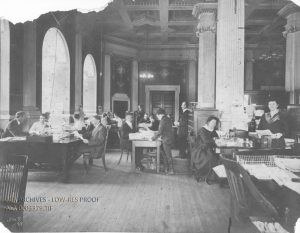
Last summer, the American Library Association moved from its long-lived location at 50 E. Huron Street in Chicago to its new location off Michigan Ave. This office were the longest held headquarters that ALA had, it was by no means the first nor was Chicago ALA’s original location. ALA’s history is filled with debates about locations and new homes.
According to Virgil F. Massman, the Association had several temporary homes in its early years, with the saying being that the Association was in Melvil Dewey’s desk drawer or wherever the ALA Secretary hung up their hat. In reality, ALA established headquarter offices at 32 Hawley Street in Boston in 1879, which were maintained by Melvil Dewey. (1)
As the Association began to grow, there were discussions on where a permanent headquarters should be located. A Committee on Permanent Headquarters was appointed by the Executive Board in 1903, which recommended that ALA relocate to New York, with Washington, D.C., and Chicago as backups. However, funding did not allow the move and ALA settled on staying in Boston for cheaper rent. A temporary office was settled at 10 ½ Beacon Street in Boston in 1905 with E.C. Hovey managing it. The following year, the first “permanent” office was established at 34 Newbury Street. But by 1907 it was apparent to the Association that they would need of a new home due to financial and staffing reasons. (2)
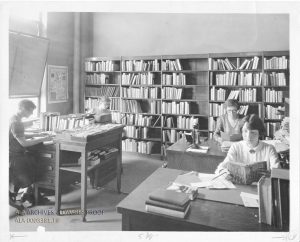
An offer came in from the Carnegie Library in Pittsburgh to provide free office space and utilities for ALA. While it was a favorable offer, there was hesitation from the Publishing Board about moving to Pittsburgh. So much so that the Publishing Board chose to help temporarily fund the Boston headquarters so other options could be considered: “Inasmuch as the Publishing board would have been seriously embarrassed by any sudden removal of headquarters or by absolute abolishment of them … action was taken by the Publishing board for such assistance in the maintenance of headquarters …” (3)
The Publishing Board even passed a resolution to express its desire to move the headquarters to New York or Chicago, “but it considers that for many reasons Pittsburgh would be an undesirable place for the Publishing board office and the Board would be reluctant to remove its office thither in any event …” (4) The Executive Board eventually made the decision to move the headquarters to Chicago. In 1909, the Chicago Public Library extended an offer to ALA to provide free office space and utilities and the Chicago Library Club agreed to providing furnishings to help with the move.
“I beg to notify you that the Board of Directors of the Chicago public library at its meeting held May 13th voted to extend an invitation to the American Library Association to move its headquarters to Chicago and offer one of the rooms in the Library for that purpose.” – H.G. Wilson, May 17, 1909. (5)
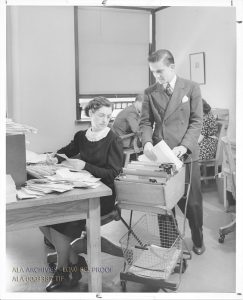
The Chicago Public Library remained the home of the Association until 1924. By then, the Association grew out of its space and moved to the ninth floor John Crerar Library, using funds from Carnegie Corporation to pay the rent. Even as some of its operations remained at the Chicago Public Library, the John Crerar Library became the official address for ALA.
Just four years later, ALA again outgrew its accommodations, finding offices for staff to be rather cramped and needing to lease warehouse space. The Executive Board appointed a Headquarters Building Committee to “make a study of the problem of Headquarters space for the next ten or twenty years.” (6) In May 1929, ALA was on the move again and settled into leased office space at 520 N. Michigan Avenue.
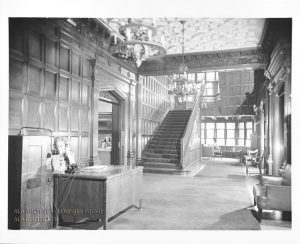
The committee fulfilled its charge and for nearly fifteen years the 520 N. Michigan Ave office was home to ALA. But again, space became a problem and in 1945 ALA purchased and renovated the Cyrus Hall McCormick Mansion at 50 E. Huron Street with staff moving in the following year. (7). However, the McCormick Mansion was not an ideal building for staff as it was a beautiful house, but less suitable as an office.
In 1955, the Executive Board asked the ALA President to appoint a subcommittee to investigate the matter. In 1957, a report by the Subcommittee on Headquarters Location addressed the question if headquarters should remain in Chicago and concluded that ALA would be better served relocating to Washington, D.C. (8) There was serious consideration to move ALA to Washington, though some worried that moving there would make ALA a lobbying group and less focused on members. Ransom L. Richardson, director of the Flint Public Library, wrote, “Even more importantly, in Washington, ALA headquarters staff could not avoid being sucked further into the maelstrom of national and international activities of the broadest educational character—to such extent, finally, that important basic services to the ALA member might well be lost in the shuffle.” (9)
The matter was brought to vote by ALA membership, with 2199 voting for Washington and 5749 in favor of Chicago. (10) ALA headquarters remained in Chicago, but there was still the question about how to move forward.
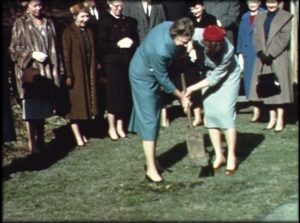
The plan was to build on the existing property. While ALA could not obtain external funding for the project, the Association was able to raise the money through endowment funds and contributions. Groundbreaking took place on November 12, 1960, the occasion was recorded for the film, ALA: Program for Progress. Staff remained at the existing McCormick Mansion until a portion of the new building was completed and moved into the new offices as the mansion was demolished and construction continued. The building was completed in 1963 and dedicated the same year during the Annual Conference in Chicago. (11) Even as the new building was designed to fit ALA’s future needs, the space issue continued to plague the Association. An expansion was added to the building and completed in 1981.
Despite all the changes to physical building, the 50 E. Huron Street address proved to be an enduring one. The property provided ALA with a home until its most recent move in 2020 to 225 N. Michigan Ave.
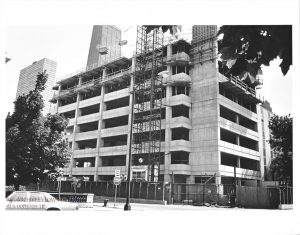
Sources:
- Virgil F. Massman, “From Out of a Desk Drawer… The Beginnings of ALA Headquarters,” ALA Bulletin, 63, No. 4 (April 1969): 475-481.
- Ibid.
- “Report of the Publishing Board,” Papers and Proceedings of the Thirtieth Annual Meeting of the American Library Association, (Boston, 1908), pg. 128-133, Record Series 5/1/2, American Library Association Archives at the University of Illinois at Urbana-Champaign.
- Ibid.
- “Minutes of the Executive Board and Council,” Papers and Proceedings of the Thirty-first Annual Meeting of the American Library Association, (Chicago, 1909), pg. 436, Record Series 5/1/2, American Library Association Archives at the University of Illinois at Urbana-Champaign.
- “Report of the Headquarters Building Committee,” Bulletin of the American Library Association, Vol. 22, No. 7 (July 1928): 261.
- Carl H. Milam, “News from the Executive Secretary,” ALA Bulletin, 39, No. 5 (May 1945): 165.
- “Location of ALA Headquarters,” ALA Bulletin, Vol. 51, No. 5 (May 1957): 349-362.
- “ALA Headquarters Location,” ALA Bulletin, Vol. 51, No. 8, (September 1957): 573-574.
- David H. Clift, “Memo to Members,” ALA Bulletin, Vo. 51, No. 10 (November 1957): 740.
- Dennis Tomison, A History of the American Library Association, 1876-1972, (Chicago: American Library Association, 1978), 206-208.